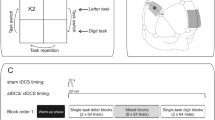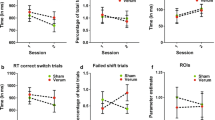Abstract
High frequency (HF) repetitive transcranial magnetic stimulation (rTMS) has an excitatory effect on neurons of a specific brain area. The dorsolateral prefrontal cortex (DLPFC) has been associated with executive functions, such as task set switching. One important experimental paradigm for investigating such higher order cognitive control is the task-switching (TS) paradigm. A TS paradigm requires switching between two conditional response tasks with mutually incompatible response–selection rules. In the present study, the influence of HF rTMS over the right DLPFC in healthy female volunteers on a modified TS paradigm was investigated. As expected, reaction time on cued switching trials decreased significant after rTMS, as compared to non-cued switch trials. No changes emerged after the placebo sham condition. Mood remained unchanged after rTMS. These findings demonstrate the role of the right DLPFC in cued intentional set switch initiation.
Similar content being viewed by others
References
Baeken C, Leyman L, De Raedt R, Vanderhasselt MA, D’haenen H (2006) Lack of impact of repetitive high frequency transcranial magnetic stimulation on mood in healthy female subjects. J Affect Disord 90(1):63–66
Brass M, von Cramon DY (2004) Selection for cognitive control: a functional magnetic resonance imaging study on the selection of task-relevant information. J Neurosci 24(40):8847–8852
Damasio AR (1996) The somatic marker hypothesis and the possible functions of the prefrontal cortex. Philosophical transactions of the royal society of London series B. Biol Sci 351(1346):1413–1420
Dreher JC, Berman KF (2002) Fractionating the neural substrate of cognitive control processes. Proc Natl Acad Sci USA 99:14595–14600
Dreher JC, Grafman J (2003) Dissociating the roles of the rostral anterior cingulate and the lateral prefrontal cortices in performing two tasks simultaneously or successively. Cereb Cortex 13(4):329–339
Forstmann BU, Brass M, Koch I et al (2005) Internally generated and directly cued task sets: an investigation with fMRI. Neuropsychologicia 43(6):943–952
Gorus E, De Raedt R, Lambert M, Lemper JC, Mets T (2006a) Attentional processes discriminate between patients with mild Alzheimer’s disease and cognitively healthy elderly. International psychogeriatrics (in press)
Gorus E, De Raedt R, Mets T (2006b) Diversity, dispersion and inconsistency of reaction time measures: effects of age and task complexity. Aging clinical and experimental research (in press)
Goschke TA (2000) Independent learning of spatio-motor and object sequences: evidence for the modularity of implicit learning. Int J Psychol 35(3–4):41–41 Sp
Meiran N, Chorev Z, Sapir A (2000) Component processes in task switching. Cognit Psychol 41(3):211–253
Milham MP, Banich MT, Webb A et al (2001) The relative involvement of anterior cingulate and prefrontal cortex in attentional control depends on nature of conflict. Cognit Brain Res 12(3):467–473
Miniussi C, Marzi CA, Nobre AC (2005) Modulation of brain activity by selective task sets observed using event-related potentials. Neuropsychologia 43(10):1514–1528
Pascual-Leone A, Valls-Sole J, Wassermann EM, Hallett M (1994) Responses to rapid-rate transcranial magnetic stimulation of the human motor cortex. Brain 117:847–858
Roalf D, Lowery N, Turetsky BI (2006) Behavioral and physiological findings of gender differences in global-local visual processing. Brain Cogn 60(1):32–42
Rogers RD, Monsell S (1995) Costs of a predictable switch between simple cognitive tasks. J Exp Psychol Gen 124(2):207–223
Rushworth MFS, Hadland KA, Paus T, Sipila PK (2002a) Role of the human medial frontal cortex in task switching: a combined fMRI and TMS study. J Neurophysiol 87:2577–2592
Rushworth MF, Passingham RE, Nobre AC (2002b) Components of switching intentional set. J Cognit Neurosci 14(8):1139–1150
Rushworth MF, Passingham RE, Nobre AC (2005) Contrasting components of attentional and intentional set-switching. Exp Psychol 52(2):83–98
Sheehan DV, Lecrubier Y, Sheehan KH, Amorim P, Janavs J, Weiller E, Hergueta T, Baker R, Dunbar GC (1998) The mini-international neuropsychiatric interview (M.I.N.I.): the development and validation of a structured diagnostic psychiatric interview for DSM-IV and ICD-10. J Clin Psychiatry 59(Suppl 20):22–33;quiz 34–57
Sohn MH, Ursu S, Anderson JR, Stenger VA, Carter CS (2000) Inaugural article: the role of prefrontal cortex and posterior parietal cortex in task switching. Proc Natl Acad Sci USA 97:13448–13453
Vanderhasselt MA, De Raedt R, Baeken C, Leyman L, D’haenen H (2006) The influence of rTMS over the left dorsolateral prefrontal cortex on Stroop task performance. Exp Brain Res 169:279–282
Van Strien (2001) Handvoorkeur en taaldominantie. Neuropraxis 2:10–15
Van Zomeren AH (1981) Reaction time and attention after closed head injury. Swets and Zeitlinger, Lisse
van Veen V, Carter CS (2005) Separating semantic conflict and response conflict in the Stroop task: a functional MRI study. Neuroimage 27(3):497–504
Wassermann EM (1998) Risk and safety of repetitive transcranial magnetic stimulation: report and suggested guidelines from the international workshop on the safety of repetitive transcranial magnetic stimulation. Clin Neurophysiol 108(Suppl 1):1–16
Wylie GR, Javitt DC, Foxe JJ (2004) The role of response requirements in task switching: dissolving the residue. Neuroreport 15(6):1079–1087
Acknowledgement
This study was supported by a grant from the Scientific Fund W. Gepts AZ VUB. The authors thank Professor Dr. R. Luypaert, P. Clerinckx and P. Van Schuerbeeck from the department of radiology for the AZ VUB technical assistance in data collection and MRI data analysis
Author information
Authors and Affiliations
Corresponding author
Rights and permissions
About this article
Cite this article
Vanderhasselt, MA., De Raedt, R., Baeken, C. et al. The influence of rTMS over the right dorsolateral prefrontal cortex on intentional set switching. Exp Brain Res 172, 561–565 (2006). https://doi.org/10.1007/s00221-006-0540-5
Received:
Accepted:
Published:
Issue Date:
DOI: https://doi.org/10.1007/s00221-006-0540-5




